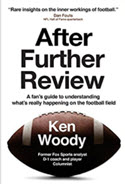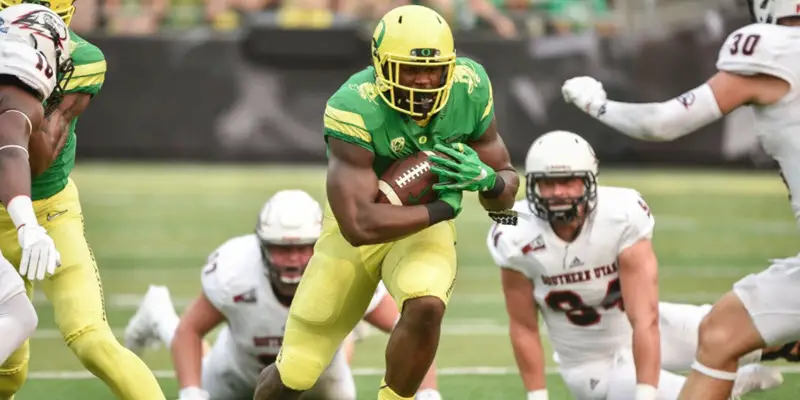Chip Kelly used to say that his spread offense, with up to four or five receivers, was designed to let the offensive linemen know who to block on running plays. By Oregon aligning its receivers wide, defensive coaches had to think hard about where they would line up their run defenders without giving up big-play pass opportunities.
Oregon head coach Willie Taggart had the Ducks give Southern Utah’s coaching staff a hard lesson with a combination of running plays coming off bizarre formations that resulted in nine rushing touchdowns and 348 yards on the ground in an easy 77-21 win over their outmatched Big Sky opponent. Let’s look at what Oregon did, and what to watch for against Nebraska on Saturday.
In the first example (above), the Ducks have two receivers stacked wide to each side of the formation, leaving five blockers against five defenders. An additional problem for Southern Utah is that Oregon also has a quarterback and running back in the backfield behind those blockers. Since the quarterback is also (or should be) counted as a runner, the defense now has only five defenders close enough to defend seven offensive players. Oregon’s right tackle blocks the end man on the line of scrimmage inside and the outside linebacker to that side comes across to cover the quarterback if he happens to pull the ball. No one is left home for the running back, as Kani Benoit cuts outside for easy yardage.
In the second example above, the same formation, the right tackle blocked his man outside and the right guard and center combo blocked the nose and inside linebacker which opened up a huge gap in the middle of the formation. The secondary, with two outside linebackers spread to cover the four wide receivers, were in no position to stop Benoit dance into the end zone for the first of three scores.
In the third example above, Benoit runs 29 yards for his second score without a hand laid on him. The Ducks brought a tight end into the formation, which brought in an outside linebacker, but the ratio of offensive to defensive players was 6-6, still one-on-one. The center and right guard handle the defensive tackle just well enough to get in the face of the SUU inside linebacker and cut off his inside path. The left guard and tackle also combo block and destroy the backside defensive tackle to make the inside backer’s path to the ball even more muddled. Benoit has some latitude in where he chooses to run, based on his judgment of the movement created by the offensive line.
In the fourth play (above), the Ducks show an unbalanced formation, still with split receivers that forced the Thunderbirds, by virtue of their game plan, to leave themselves thin on the line of scrimmage. The center and right guard combo blocked the nose tackle and backside linebacker while the tight end and right tackle released inside and totally sealed a running alley just outside the tight end. The unblocked outside linebacker had to maintain responsibility for quarterback Justin Herbert, leaving no one to cover the dive, who happened to be in the form of 238-pound Royce Freeman, who rushed for 150 yards and four touchdowns this game.
Taggart: “let’s feed the horse”
Willie Taggart was a run first, pass second quarterback when he played at Western Kentucky. If things go the way he’d like this season, the Ducks will run at least 60% of the time, “feeding the horse,” as he calls Freeman, who has gained some quickness and speed from last season. The days of running untouched for scores will likely be cut down some as the quality of opponents (and defenses) becomes stronger as the season progresses. However, if the Ducks can force defenses to continue spreading out to defend outside receiving threats, the inside run will be an attractive opportunity.
As a fan, look for this against Nebraska:
Look for what defenses will do to try solving this conundrum, such as aligning big defenders on smaller receivers, running some man-to-man coverage to allow another run defender inside, or having big physical defensive linemen who can’t be single blocked. When that happens, you’ll probably see Herbert running the option more, as this will require the defense to use a player to defend him as a ball carrier (whether he carries the ball or not) to go along with Benoit, Freeman, or Tony Brooks-James.
As the game progresses, make a quick count of defenders in the “box,” which is the imaginary rectangle in front of the offensive line that is the width of the offensive line and about 3-5 yards deep, encompassing both the first level (defenders on line of scrimmage) and second level (where the linebackers line up behind the defensive linemen). Notice how they are matched up against the offensive front. If you see an imbalance, you can anticipate some offense directed that way, “feeding the horse” behind an improving offensive line.
Coach Ken Woody
Eugene, Oregon
Ken Woody is a former Fox Sports football commentator who played defensive back, receiver and kicker for Oregon from 1966 to 1970. He coached college football for 18 years, including stints as an assistant coach at Oregon, Washington, Washington State and Utah State, and was head coach at Whitman College and Washington University-St. Louis.
 Top Photo by Kevin Cline
Top Photo by Kevin Cline
Buy the book to learn from Coach Woody, or give a gift of football.
“Every Oregon fan should have a copy to learn from as I do.” Charles Fischer
Related Articles:
Seven Offensive Coordinator Candidates for the Oregon Ducks
Five Candidates to Replace OC Marcus Arroyo
Coach Jim Mastro: The Perception, and the Truth
Has Oregon Turned the Corner on Offense?
Ducks, Taggart Punish Beavers; Earn Bowling Trip
Textbook Defense, Herbert's Return Energize Duck Victory; Civil War Next
“I learned football working under many great coaches, among them Len Casanova, Jerry Frei, John Robinson, Bruce Snyder, George Seifert,and Ron Stratten at the University of Oregon, Jim Owens at the University of Washington and Jim Walden at Washington State University. Most of my coaching experience was on the offensive side of the ball with quarterbacks, receivers and kickers although as a head coach I coached defensive backs, linebackers and offensive line.
I achieved my first goal of being the youngest head coach in college football at the age of 26 and throughout my career in coaching and outside of it, as a journalist and broadcaster, have experienced how exciting and gratifying it is teaching the game to others.”

